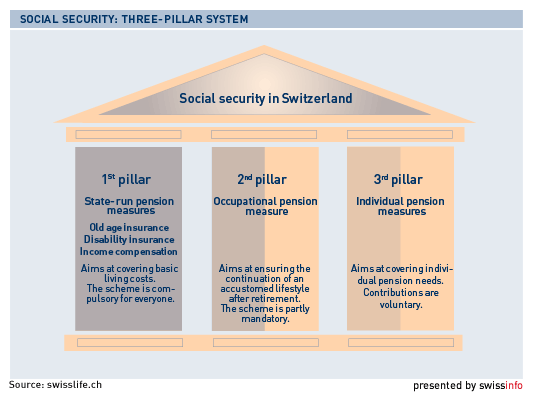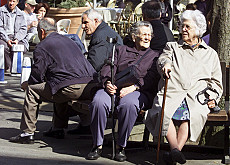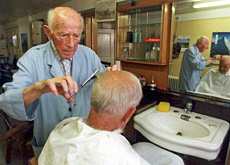Swiss search abroad for retirement inspiration

Researchers in Lausanne have studied how Switzerland's neighbours have reformed their retirement systems in order to find solutions for home.
The ageing Swiss demographic is one of the greatest challenges facing the country’s retirement system. Today there are just four people working for every retired person. By 2050 experts believe that ratio will halve, potentially causing the system to collapse
So at the request of the Federal Social Insurance Office, a team of experts from the Graduate School of Public Administration in Lausanne looked at reforms made in Germany, France, Italy, Sweden and the Netherlands. The goal is to provide the Swiss government with information on how best to make future reforms.
The study found big steps are easier to digest than small ones. “It’s a fact that radical reforms are adopted more easily than limited ones,” said project leader Giuliano Bonoli.
He added however that it was necessary for the changes to draw upon largely acknowledged principles. Among them would be flexibility in retirement age, establishing a link between benefits and the population and the economy, as well as a compensation scheme including penalising factors.
Regional variations
In the countries studied, flexible retirement age is often linked to factors such as difficulty in continuing a job, life expectancy in a particular professional category and how long a person has been working.
To help offset the variables in Italy, workers under the age of 18 must make payments into the system at one-and-a-half times the normal rate.
Another way to make reforms is to look at independent indexing mechanisms.
“In practical terms it’s a matter of tools that don’t constantly demand a political decision. Once defined, they have an automatic impact on annuity adjustments,” Bonoli said.
“In Switzerland we already have a mechanism like this at our disposal. The revenue index is in effect carried out automatically every two years while considering the average between salaries and prices.”
Combined solution
The Swiss could have advantages by combining different measures while eliminating the notion of an ordinary retirement age and allowing more flexibility, according to the study.
Annuities, for example, should be collectable after the age of 60 or 62 with reduced benefits in certain cases. A higher limit, 70 for example, could also be introduced.
According to the experts in Lausanne, a partial annuity should also be allowed.
The study looked at the idea of a system based on professional effort and a family coefficient. That would take into consideration the age of retirement as well as the number of years a worker pays into the system. That way, people with little qualifications who started a job early in life would still have advantages.
In general, the researchers favoured the idea of making benefits directly dependent on demographic and economic progress. For example, according to the health of the federal pension fund the revenue index could be based on a mixed index or even suspended.
The authors also suggested how to finance old-age insurance: by changing the way value-added tax is calculated, which would not be detrimental to the economy.
Further the debate
Yves Rossier, director of the Social Insurance Office, stressed that the goal of the study wasn’t to interfere with the current political discussion.
“It’s a matter of providing new elements to the debate in anticipation of future changes,” he said.
For his part, Bonoli recommended a global solution and more in-depth studies and called for better coverage for disadvantaged people.
swissinfo, based on an article in Italian by Andrea Clementi
The state old-age pension scheme is funded jointly through contributions by employers and employees.
The plans for the latest reform of the scheme foresee raising the retirement age for women by one year to 65, in line with that of men.
The reform also includes ways of facilitating earlier retirement, the option of putting off retirement, as well as new funding mechanisms to adapt pensions to inflation.
Another proposal wants to impose a levy to finance an early retirement scheme.
The number of old age pensioners was 1.755 million in 2007. The scheme recorded a surplus of SFr2.7 billion in 2006.
Individual pensions benefits ranged from SFr1,105 to SFr2,210 per month. Married couples received up to SFr3,315.


In compliance with the JTI standards
More: SWI swissinfo.ch certified by the Journalism Trust Initiative


You can find an overview of ongoing debates with our journalists here . Please join us!
If you want to start a conversation about a topic raised in this article or want to report factual errors, email us at english@swissinfo.ch.